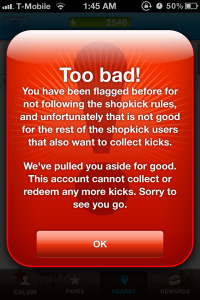Archive
Shopkick and Causeworld
The folks who started the non-profit Causeworld wanted to find a way to raise money for charitable causes. So they put together a mobile app that provided a way to “bring the physical and virtual worlds of retail together. Causeworld is a mobile app by the makers of Shopkick which lets users check-in to stores to earn money to be used for donations.
Causeworld is a similar check-in application where users can only give their points to nonprofits. When Causeworld users went to the new for-profit version, Shopkick, the community grew to almost four times the size of Causeworld, and a sizable part of the users still decided to give their rewards to charities. Though a smaller percentage currently donate, the massive growth in users means that a greater number donate, making the aggregate contribution more charitable than under CauseWorld.
Shopkick is a good example of how the for-profit industry can sometimes make a greater social impact than the nonprofit world. Shopkick has created a more charitable community since it decided to ditch its charity business model and focus on giving users rewards with virtual currency for completing various check-in tasks at selected retailers, which can then be exchanged for products or used to give equivalently to a charity.
Here a few numbers on to compare CauseWorld to ShopKick in july 2011:
A carbon offsetting project:
- CauseWorld: 2,133 donations per month
- Shopkick: 2,673 donations per month
A charity to prevent child abuse:
- CauseWorld: 667 donations per month
- Shopkick: 1,257 donations per month
A breast cancer charity:
- CauseWorld: 533 donations per month
- Shopkick: 964 donations per month
Shopkick is one of the company that proves that combining charity and profit is more beneficial to all involved. Thanks to Shopkick, some charities received double the number of monthly donations.
However, Shopkick is forbidden from disclosing actual donation numbers, so there is no way to verify if the total dollar amount going to charity has increased but we know that users are giving more often.
Sources : http://www.triplepundit.com/2011/07/shopkick-spoonful-profit-helps-charity/
Shopkick Key Figures in April 2012

As of April, shopkick.com is 5 Years, 5 Months, 23 Days old
- IP address is 174.143.154.94
- Located at San Antonio, Texas, United States
- SEO score of 73.9%
- Shopkick value $8,731.00
- Ranked #82,575 on the world wide web (the lower the rank, the popular the website is)
- Average page load time to be 0.644 seconds (88% of sites are slower)
- PageRank of 6/10
- Alexa Traffic Global Rank: 98 487
- Shopkick growth:
- 18,093 unique visitors per day which produce a total of 39,805 page-views
- Time on site : between 2 and 3 minutes
- Google indexed 238 pages, Yahoo indexed 220 pages and Bing indexed 183 pages
- Shopkick regional traffic ranks:
- United-States: 37 128
- Turkey: 66 433
- United Kingdom: 85 541
- Audience demographics:
- Android app store
- Installs: 1 to 5 million
- Ratings: 55,202 (Average rating = 4.4/5)
- iTunes app store
- Ratings: 27953 (Average rating = 3/5)
Local Businesses Can Take Advantage of Shopkick Too
By definition, Shopkick is a mobile loyalty platform that rewards customers for shopping at participating stores. Therefore, this is a good opportunity for small-business owners established in 10 major cities, which include New York, Los Angeles, San Francisco, Chicago, Dallas, Houston, Seattle, Washington, D.C., Detroit and New Orleans, to boost foot traffic and encourage current customers to visit more frequently. However, Shopkick main interesting partners are mainly coffee shops, bakeries, restaurants and local clothing. Once a small business has been selected, Shopkick will handle the installation of its in-store signaling hardware and monitor the activity of participating users. Local merchants can sit back and relax, without having to worry about rotating special deals or tracking how many customers have checked-in. Merchants are expected to pay less than $100 for Shopkick’s in-store tracking hardware, along with a commission fee based on the points their customers earn and the number of transactions completed by shoppers with the app. Moreover, the big name partner companies, such as American Eagle and Best Buy, make the application successful {how do they make the app successful, or maybe you mean a different word than successful(maybe popular/well known)}. Therefore, local merchants don’t need to invest money in promoting the app or educating customers on how to use it.
Shopkick has eliminated the manual check-in that makes it easier for shoppers to participate in loyalty programs and earn points. Merchants are given plenty of latitude in creating the rewards and incentives they offer to Shopkick users, as well as the activities and tasks that customers can complete to earn points. At Sports Authority, for example, customers will often receive extra points for interacting with selected in-store displays and scanning barcodes on merchandise that the retailer is currently promoting. Smaller businesses that can’t afford to give away gift cards and 50 percent-off coupons can get creative with the incentives they offer. Coffee shops and bakeries can give away free cups of coffee or muffins. Clothing stores and other local retailers can reward Shopkick customers with sneak peaks of their latest merchandise and first-access to exclusive sales.
Source:








